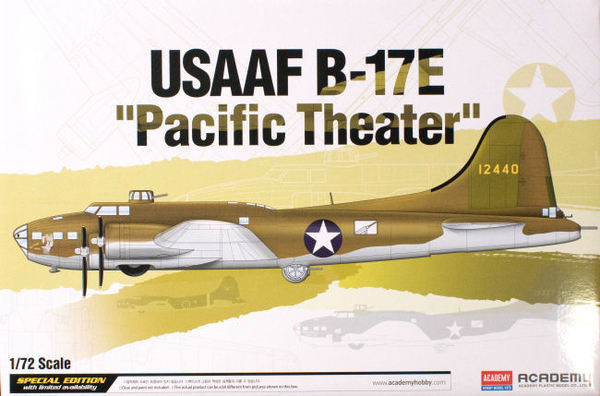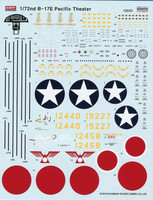
Academy 1/72 USAAF B-17E "Pacific Theater"
By Jacob Russell
The Plane
The Boeing B-17 was a four-engined, heavy bomber used by the USAAF (United States Army Air Force) during the Second World War. The USAAF used the B-17 primarily in the daylight strategic bomber role, in raids against German military and industrial targets. Boeing built the Model 299 (B-17 prototype) at their own expense, in response to a 1934 USAAC (United States Army Air Corps) proposal to replace the Martin B-10 bomber. The Model 299 flew for the first time on July 28, 1935.
|
|
The B-17E made its first flight on September 5, 1941. It featured a fuselage lengthened by 10 feet, and an enlarged vertical tail fin, rudder and horizontal stabilizers, among other design changes. It also had an electric manned dorsal turret behind the cockpit, and another ventral ball turret just aft of the bomb bay, both of which were built by Sperry. The B-17 was powered by the turbocharged Wright R-1820 Cyclone 9 radial engine.
|
|
The Kit
This is a reissue of Academy's B-17E kit with new decals. It consists of 160 parts on 8 sprues, 3 of which are clear. 18 of the parts are not applicable to this B-17 variant and will end up in your spares box. The kit is well molded. All panel lines are recessed, albeit of a uniform depth. There is no sidewall detail on the insides of the fuselage halves. The cockpit is composed of 15 rather basic parts. The B-17E cockpit was a busy area and it was painted Zinc Chromate Green. This is a rather bright color, especially if you factor in "scale effect," so you might want to spend some time adding wiring, consoles, etc. There is a complete bomb bay with 8 bombs. None of this detail will be visible unless you open the bomb bay doors.
|
|
The kit shows its age in its simplified small parts, like the engines, superchargers, turret guns and the main wheels. These are adequate, but if so inclined you could replace them with aftermarket items. In the case of the kit superchargers, you should drill out the exhaust tips if you use them.
|
|
Academy took a novel approach to the tail gunner position: they molded the entire tail in clear plastic, so that all you have to do is mask the rear windows rather than have to install a couple of rather small windows.
The fuselage halves, wings and tail planes have decent surface detail. I mentioned earlier that the panel lines are both recessed and of a uniform depth. You might consider deepening some of them, or adding some rivets, with the aid of your favorite riveting tools, to enliven what will otherwise be large expanses of monochromatic plastic: all of the decal options are overall Olive Drab over Neutral Grey.
|
|
The decal sheet is well printed, glossy, in-register and it has bright colors. It also includes an instrument panel decal, seat harnesses, wing walks and a complete set of stencils and national insignia. All 4 decal options are overall Olive Drab over Neutral Grey:
B-17E, 41-2440, "Calamity Jane," 98th BS/11th BG., South Pacific, 1942-43.
B-17E, 41-2458, "Yankee Didd'ler," 65th BS/43rd BG., South-West Pacific, 1942-1943.
B-17E, 41-9227, "Yankee Doodle, Jr.," 431st BS/11th BG., South Pacific, 1942-1943.
B-17E, Unknown number, 19th BG., after capture by Japanese Army Air Force, Bandung Air Base, Spring 1942.
The instructions are up to Academy's usual standards. They include a parts map and color callouts for Humbrol (enamels and acrylics), GSI Creos (Aqueous Hobby Color and Mr. Color lacquer), Lifecolor, Testors/Modelmaster (enamels and acrylics), Revell (enamels and acrylics), and Vallejo (Model Color and Model Air) paints. The instructions are also well illustrated with a logical build sequence.
|
|
Conclusion
This is a pretty good kit. It is fairly accurate and it has a reasonable level of detail. There are many aftermarket decal sheets, resin wheels and engines, photo-etch sets, etc. available if you're feeling ambitious. Academy's B-17 isn't the only game in town (Hasegawa, Airfix and Revell also have B-17 kits). But it should be an easy build and well, it looks like a B-17. That's half the battle! I recommend this kit and I would like to thank Model Rectifier Corporation for the review sample.
References
Wikipedia: https://en.wikipedia.org/wiki/Boeing_B-17_Flying_Fortress
B-17 Walk around:https://www.aircraftresourcecenter.com/AWA1/101-200/walk164_B-17/walk164.htm

|
